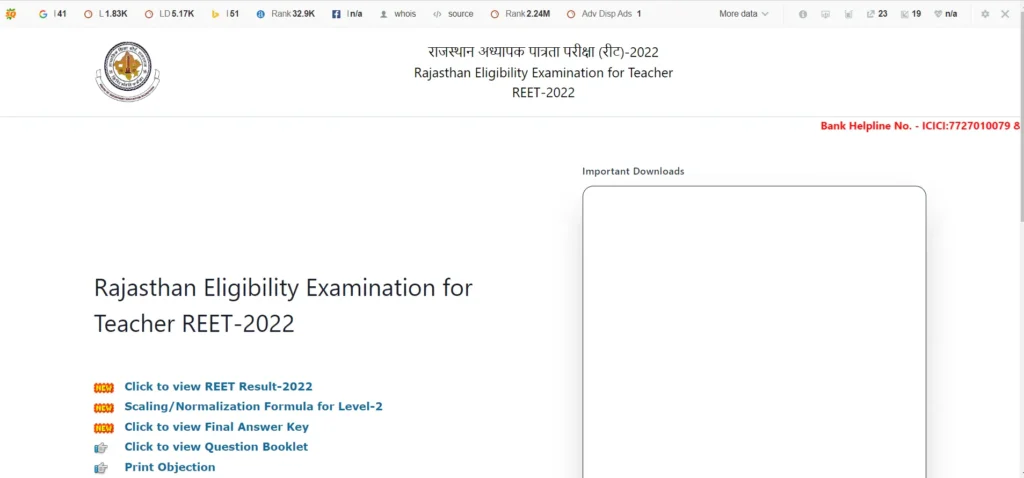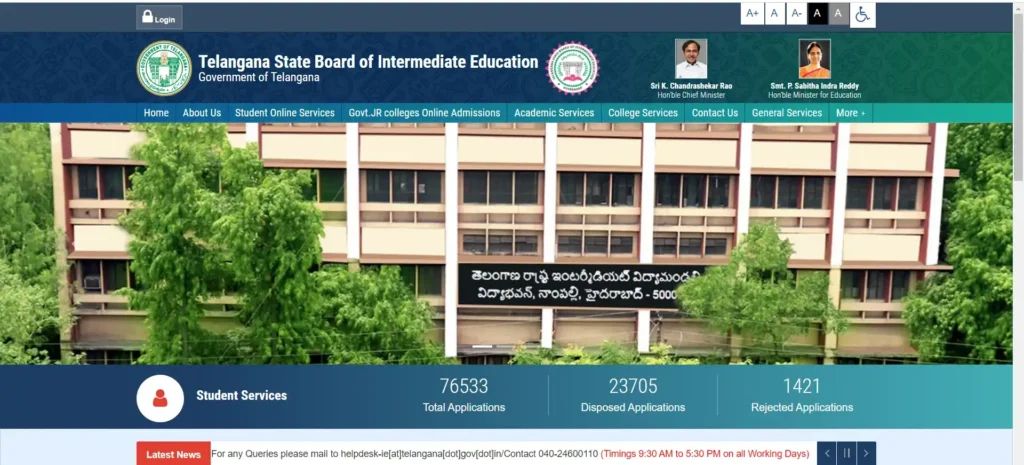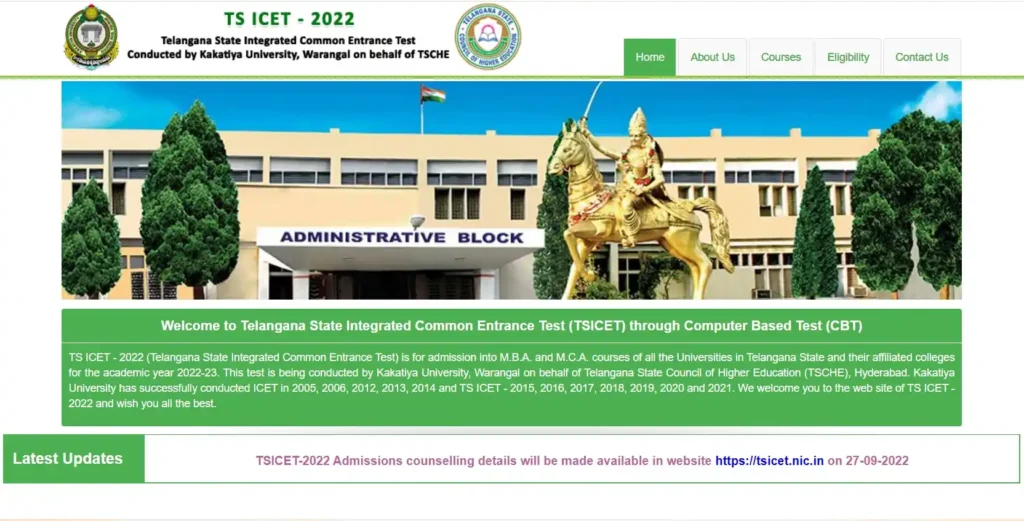Rajasthan Eligibility Examination for Teacher REET 2022 Declared by The Board of Secondary Education, Rajasthan (BSER).
Check the REET 2022 Result at https://reetbser2022.in/result-2022

How to Check the Result
Log on to Check the REET 2022 Result at https://reetbser2022.in/result-2022
Enter the Candidate Roll No. Enter the Candidate’s Date of Birth and Submit.
Check, Save REET Result 2022, and take a print of it.
Check the Rajasthan Eligibility Examination for Teacher REET-2022 Answer Key Shift – I (L1)
Check the Rajasthan Eligibility Examination for Teacher REET-2022 Question Booklet A for Shift – I (L1) Shift – II (L2) Shift – III (L2) Shift – IV (L2)
Check the Rajasthan Eligibility Examination for Teacher REET-2022 Answer Key Shift – II (L2)
Check the Rajasthan Eligibility Examination for Teacher REET-2022 Question Booklet B for Shift – I (L1) Shift – II (L2) Shift – III (L2) Shift – IV (L2)
Check the Rajasthan Eligibility Examination for Teacher REET-2022 Answer Key Shift – III (L2)
Check the Rajasthan Eligibility Examination for Teacher REET-2022 Question Booklet C for Shift – I (L1) Shift – II (L2) Shift – III (L2) Shift – IV (L2)
Check the Rajasthan Eligibility Examination for Teacher REET-2022 Answer Key Shift – IV (L2)
Check the Rajasthan Eligibility Examination for Teacher REET-2022 Question Booklet D for Shift – I (L1) Shift – II (L2) Shift – III (L2) Shift – IV (L2)
Check the Scaling and Normalizing Formula for Level -2
REET 2022
REET 2022 Examination was conducted by The Board of Secondary Education, Rajasthan (BSER). The exam was successfully conducted on July 23 & 24, 2022 in offline mode in Rajasthan.
The successful candidates in the REET 2022 will get the Teacher’s eligibility test certificate which they can use to get a teacher job in the Rajasthan State.
| Examination Name | Rajasthan Eligibility Examination for Teacher (REET) |
| Examination Conducting Authority | Board of Secondary Education, Rajasthan (RBSE) |
| Level of Examination | Rajasthan State Wide |
| Mode of Examination | Offline in pen and paper model |
| Duration of the Examination | Paper 1: 150 minutes Paper 2: 150 minutes |
| Languages | English and Hindi |
| Vacancies | 62,000 vacancies for Level 1 and 2 |
| Date of Examination | July 23 & 24, 2022 |
| Official Website | www.reetbser2022.in and http://rajeduboard.rajasthan.gov.in/ |
REET Exam Scheme 2022
There is a revision in the Exam pattern in REET 2022. Candidates should be familiar with the examination pattern and Syllabus to secure good scoring in the REET 2022.
The examination will comprise of 150 questions for 1 mark each.
The duration of the exam is 2.5 hours for each paper.
There is no negative marking in REET Eligibility Test.
Paper 1 is for Primary level i.e. class I to V
Paper 2 is for secondary level i.e. class VI to VIII.
REET Paper-I (for Classes I to II) Primary Stage
| REET Level-1 Exam Pattern (Class 1 to 5) | ||||
| S.No. | Subjects | No. of Questions | Marks | Time Duration |
| 1 | Child Development and Pedagogy (बाल विकास एवं शिक्षण विधिया) | 30 | 30 | 150 Minutes |
| 2 | Language I (compulsory) (भाषा-1 हिन्दी/अंग्रेजी/संस्कृत/उर्दू/सिंधी/पंजाबी/गुजराती) | 30 | 30 | |
| 3 | Language II (compulsory) (भाषा-2 हिन्दी/अंग्रेजी/संस्कृत/उर्दू/सिंधी/पंजाबी/गुजराती) | 30 | 30 | |
| 4 | Mathematics (गणित) | 30 | 30 | |
| 5 | Environmental Studies (पर्यावरण अध्ययन) | 30 | 30 | |
| Total | 150 | 150 |
REET Paper-II (for Classes VI to VIII) Elementary Stage
| REET Level-2 Exam Pattern (Class 6 to 8) | |||
| Subject | Questions | Marks | Time Duration |
| Child Development & Pedagogy (बाल विकास एवं शिक्षण विधिया) | 30 | 30 | 150 minutes |
| Language 1 (भाषा-1 हिन्दी/अंग्रेजी/संस्कृत/उर्दू/सिंधी/पंजाबी/गुजराती) | 30 | 30 | |
| Language 2 (भाषा-2 हिन्दी/अंग्रेजी/संस्कृत/उर्दू/सिंधी/पंजाबी/गुजराती) | 30 | 30 | |
| Mathematics & Science (For Maths & Science Teacher) Social Science for Social Science Teachersगणित एवं विज्ञानं के शिक्षक हेतु – गणित एवं विज्ञानं विषय | 60 | 60 | |
| Total | 150 Questions | 150 Marks |
REET Syllabus 2022
Child Development & Pedagogy
- Child Development: Concept of growth and development, Principles and dimensions of development. Factors affecting development (especially in the context of family and school) and its relationship with learning.
- Role of Heredity and Environment
- Meaning and Concept of learning and its processes. Factors Affecting learning
- Theories of learning (Behaviourism, Gestalt, Cognitivism, Constructivism) and its implications
- How children learn, Learning process, Reflection, Imagination, and Argument, constructivism, experiential learning, concept mapping, investigatory, approach, problem-solving
- Motivation and Implications for Learning
- Individual Differences:- Meaning, Types, and Factors Affecting Individual differences Understanding individual differences.
- Personality:- Concept and types of personality, Factors responsible for shaping it and Its measurement
- Intelligence:- Concept, Theories, and its measurement. Multidimensional Intelligence and Its implication.
- Understanding diverse learners:- Backward, Mentally retarded, gifted, creative, disadvantaged and deprived, specially-abled, CWSN, children with learning disabilities
- Learning Difficulties.
- Adjustment:- Concept and ways of adjustment. Role of teacher in the adjustment.
- Teaching-learning process, Teaching learning strategies and methods in the context of National Curriculum Framework 2005.
- Meaning and purposes of Assessment, Measurement, and Evaluation. Comprehensive and Continuous Evaluation. Construction of Achievement Test, Learning outcomes
- Action Research.
- Right to Education Act 2009 (Role and Responsibilities of Teachers)
REET 2022 English Syllabus
- Unseen Prose Passage
- Synonyms, Antonyms, Spellings, Word-formation, One Word Substitution
- Unseen Prose Passage
- Parts of Speech, Tenses, Determiners, Degrees of comparison
- Framing Questions Including Wh-questions, Active and Passive Voice,
- Narration, Knowledge of English Sounds and Phonetic Symbols
- Principles of Teaching English, Methods and Approaches to the English Language Teaching
- Development of Language Skills, Teaching Learning Materials: (Textbooks, MultiMedia Materials and other Resources)
- Comprehensive & Continuous Evaluation, Evaluation in the English Language.
REET Syllabus for Hindi
| एक अपठित गद्यांश में से निम्नलिखित व्याकरण संबंधी प्रश्न:शब्द ज्ञानतत्समतद्भवदेशजविदेशी शब्दपर्यायवाचीविलोमएकार्थी शब्द |
| एक अपठित गद्यांश में से निम्नलिखित बिंदुओं पर प्रश्न:रेखांकित शब्दों का अर्थ स्पष्ट करनावचनकाललिंग ज्ञात करनादिए गए शब्दों का वचन काल और लिंग बदलना |
| वाक्य रचना, वाक्य के अंग, वाक्य के प्रकार, पदबंध, मुहावरे और लोकोक्तियाँ,विराम चिन्ह। |
| भाषा की शिक्षण विधि, भाषा शिक्षण के उपागम, भाषा दक्षता का विकास। |
| भाषायी कौशलों का विकास (सुनना, बोलना, पढ़ना, लिखना) हिंदी भाषा शिक्षण में चुनौतियाँ, शिक्षण अधिगम सामग्री, पाठ्य पुस्तक, बहु-माध्यम एवं शिक्षण के अन्य संसाधन। |
| भाषा शिक्षण में मूल्यांकन, उपलब्धि परीक्षण का निर्माण समग्र एवं सतत् मूल्यांकन, उपचारात्मक शिक्षण। |
REET 2022 Syllabus for Social Studies
- Indian Civilization, Culture, and Society – Indus valley civilization, Vedic culture, Jainism and Buddhism, Mahajanpadas
- Mauryan & Gupta Empires and Post-Gupta Period –Political history & administration, contribution to Indian culture, India (600-1000 AD), Greater India
- Medieval and Modern Period –The Bhakti and Sufi Movement, Mughal-Rajput relations; Mughal administration, British policies towards Indian states, Revolt of 1857, Impacts of British Rule on Indian Economy, Renaissance and Social reforms, Indian National Movement (1885-1947)
- Indian Constitution and Democracy – Making of the Indian Constitution and its features, Preamble, Fundamental Rights and Fundamental duties, Social justice, Child Rights and Child Protection, Election in Democracy and Voters Awareness.
- Government: Composition and Functions –Parliament, President, Prime Minister, and Council of Ministers; Supreme Court, State Government, Panchayati Raj, and Urban Self–Government. (in reference to Rajasthan) District Administration and Judicial System.
- Earth and Our Environment – Latitude, Longitude, Earth`s Movement, Air Pressure and winds, Cyclone and Anti-cyclone, Solar and Lunar Eclipse, Major climate zone of the earth, Biosphere, Environmental Problems, and Their Solutions
- Geography and Resources of India – Physiographic regions, Climate, Natural vegetation, Wild Life, Multipurpose River-valley projects, Soil, Agriculture crops, Industries, Minerals, Transportation, Population, and Human Resources. Economic and Social Programmes of Development
- Geography and Resources of Rajasthan – Physical regions, Climate, and drainage system, Lakes, Water conservation and Harvesting, Agriculture, Soil, Crops, Minerals, and Energy Resources, Major Canales and River-valley projects of Rajasthan, Transport, Industries, Population, Tourist Places of Rajasthan, Forest, and wildlife
- History of Rajasthan – Ancient Civilizations and Janpadas, History of major dynasties of Rajasthan, Contribution of Rajasthan in the revolt of 1857, Prajamandal, Tribal’s and Peasant Movement in Rajasthan an, Integration of Rajasthan, Major Personalities of Rajasthan.
- Art and Cultural of Rajasthan – Heritage of Rajasthan (Forts, Palaces, Monuments ) Fairs, Festivals, Folk-arts of Rajasthan, Painting of Rajasthan, Folk dance and folk Drama of Rajasthan, Lok- Devta, Lok Saint, Folk Music and Musical Instruments of Rajasthan, Handicrafts, and architecture of Rajasthan, Dresses, and Ornaments of Rajasthan, Languages, and Literature of Rajasthan.
- Insurance and Banking System – Types of Insurance and Bank, Reserve Bank of India and its Functions, Cooperatives and Consumer Awareness
- Pedagogical Issues – I Concept & Nature of Social Science/Social Studies; Class Room Processes, activities and discourse; Problems of teaching Social Science/Social Studies; Developing critical thinking.
- Pedagogical Issues – II Enquiry/Empirical Evidence; Teaching Learning Material and Teaching Aids, Information and Communication Technology. Project Work, Learning outcomes, Evaluation
General Science Syllabus
- Living & Non Living: Introduction, Differences, and characteristics
- Micro-organisms: Bacteria, viruses, fungi (Beneficial & Harmful)
- Living Being: different types and parts of plants, nutrition in plants, respiration and excretion, plant cell and animal cell- their structure and Function, Cell Division
- Human body and health: Diseases spread by micro-organisms, (tuberculosis, measles, diphtheria, cholera, typhoid); prevention from diseases; different systems of the human body; infectious diseases (reasons of spreading and prevention); Sources of Food, Major components of food and diseases developed due to their deficiency; Balanced diet;
- Animal Reproduction and Adolescence: Methods of Reproduction; Sexual and asexual. Adolescence and puberty: Changes in the body, the role of hormones in reproductions, Reproductive health
- Mechanics- Force and Motion, Types of forces- (muscular force, frictional force, gravitational force, magnetic force, electrostatic force), Pressure, Types of motion (linear, zigzag, circular, vibrating, periodic) speed. Atmospheric Pressure Buoyancy force, work, and energy, traditional and alternative sources of energy, energy conservation
- Heat and Temperature: Heat and Temperature mean, thermometers, Heat Transmission (conduction, convection, and radiation).
- Light & Sound: Sources of light, the reflection of light, Spherical mirrors, Image formation by plane and Spherical Mirrors, Refraction of Light, Lenses and Image formation by Lenses, Sound, Characteristics of sound, Sound propagation, sound pollution.
- Electricity and magnetism- Electric Current, Electric Circuit, Heating, magnetic and Chemical effects of current, magnet and magnetism.
- Science and Technology: Importance of science in daily life; Synthetic Fibers & Plastics-Types and characteristics of synthetic fibers. Plastic and its properties, Plastic and environment, detergents, cement, etc.; Science and Technology in the medical field (X-ray, C.T. Scan, Surgery, Ultrasound and LASER): In the field of Telecommunication – general information about the fax machine, computer, internet, e-mail, and website.
- Solar System: Moon and stars, Solar family-Sun and Planets, Comets, Constellation
- Structure of Matter: Atom and molecule; structure of the atom; element, compound, and mixture; separation of impurities of substances; symbols of elements, chemical formulae of compounds and chemical equations, physical and chemical change.
- Chemical Substances: Oxides, greenhouse effect and global warming, Hydrocarbon (Introductory knowledge), Acid, Alkali and Salt, Oxygen gas, Nitrogen gas, and nitrogen cycle, Coal, Petroleum, and natural gas
- Nature & Structure of Sciences
- Natural Science: Aims & objectives, Natural resources, Environment, Pollution and Control, Biodiversity, adaptation, waste management.
- Agriculture Management: Agriculture Practices, Major crops are grown in Rajasthan
- Organic Evolution
- Understanding the Science
- Methods of Science Teaching
- Innovation
- Text Material/Aids
- Evaluation
- Problems
- Remedial Teaching
REET 2022 Syllabus for Mathematics
Indices: Multiplication and division of numbers on equal bases, Laws of Indices.
Algebraic expressions: Addition, Subtraction, Multiplication and Division, Identities
Factors: factors of simple algebraic expressions
Equations: Simple linear equation.
Square & Square Root
Cube & Cube Root
Interest: Simple interest, Compound interest, Profit – Loss.
Ratio and Proportion: Division into proportional parts, Fraction.
Percentage: Birth and Death rate, Population growth, Depreciation
Lines and Angles: Line segment, straight and curved lines, types of angles.
Plane figures: Triangles, Congruence of Triangles, Quadrilaterals, and Circle.
Area and Perimeter of Plane figure Triangles, Rectangles, Parallelograms, and Trapeziums.
Surface Area and Volume: cube, cuboid, and right circular cylinder.
Statistics: collection and classification of data, frequency distribution table, Tally marks, bar graph and histogram, circular graph (Pai diagram).
Graph: Various types of graphs.
Probability
Nature of Mathematics/Logical thinking
Place of Mathematics in Curriculum
Language of Mathematics
Community Mathematics
Evaluation
Remedial Teaching
Problems of Teaching
Environment Studies Syllabus
Family – Personal relationships, nuclear and joint families, social abuses (child marriage, dowry system, child labor, theft); addiction (intoxication, smoking) and it’s personal, social, and economical bad effects.
Clothes and Habitats – Clothes for different seasons; maintenance of clothes at home; handloom and power loom; habitats of living beings, various types of houses; cleanliness of houses and neighbouring areas; Different types of materials for building houses.
Profession – Profession of your surroundings (stitching clothes, gardening, farming, animal rearing, vegetable vendor, etc.), small and cottage industries; major industries of Rajasthan State, Need for consumer protection, co-operative societies.
Public places and Institutions – Public places like schools, hospitals, post offices, bus stands, railway stations; Public property (street light, road, bus, train, public buildings, etc.); wastage of electricity and water; employment policies; general information’s about Panchayat, legislative assembly, and parliament.
Our Culture and Civilization and Pride – Fairs and festivals of Rajasthan, National festivals, Dresses, and ornaments of Rajasthan, food-habits, architecture, fort, places, painting and art and craft of Rajasthan; Tourist places of Rajasthan; Great personalities of Rajasthan, Proverb of Maharana Pratap, Mahatma Gandhi
Panchyat Raj and Urban Self government in Rajasthan
Transport and Communication – Means of transport and communication; Rules for pedestrians and transport, traffic symbols, Effects of means of communication on the lifestyle.
Personal Hygiene – External parts of our body and their cleanliness, general information about the internal parts of the body; Balance diet and its importance; Common diseases (gastroenteritis, amoebiasis, methemoglobin, anemia, fluorosis, malaria, dengue.) their causes and methods of prevention: Pulse Polio campaign.
Living Beings– Levels of organization of plants and animals, diversity of living organisms, state flower, state tree, state bird, state animal; knowledge of reserve forest and wildlife (national parks, sanctuaries, tiger reserve, world heritage), conservation of species of plants and animals, agriculture species.
Water – Basic knowledge of water, forest, wetlands, and deserts, different kind of pollution and pollution control, Water Properties. Sources, Management.
Mountaineering – Equipment, Problem, Main women mountaineer of India
The Earth and Space – Our Solar Systems, Indian Astronauts
Concept and scope of Environment Studies
Significance of Environment Studies, Integrated Environment Studies
Environmental Studies & Environmental Education learning Principles
Scope & relation to Science & Social Science
Approaches of presenting concepts
Activities
Experimentation/Practical Work
Discussion
Comprehensive and Continuous Evaluation
Teaching material/Aids
Problems of Teaching
Check our other Articles/Information on Education, Jobs and Exam Results

